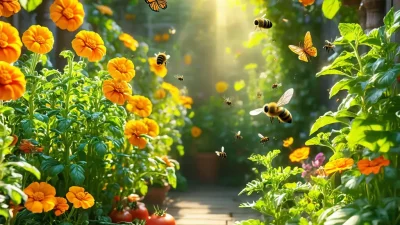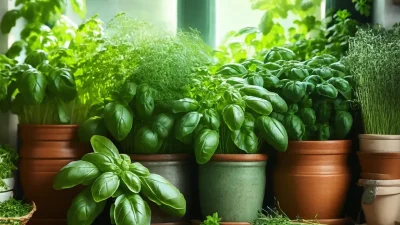The Ultimate Guide to Growing Herbs Indoors
Gardening doesn’t have to be confined to outdoor spaces. With the right setup, you can grow fresh herbs indoors year-round, bringing a touch of nature into your home. Whether you’re an experienced gardener or just starting out, this guide will walk you through everything you need to know about growing herbs indoors.
Why Grow Herbs Indoors?
There are plenty of reasons to consider growing herbs inside. For starters, having fresh herbs on hand can elevate your cooking and save you money on grocery bills. Plus, indoor herb gardens are a great way to bring nature into your living space, improving air quality and adding a touch of greenery to your decor.
- Convenience: Snip fresh herbs whenever you need them
- Purity: Avoid pesticides and chemicals found in store-bought herbs
- Cost-effective: Reduce grocery expenses by growing your own herbs
- Therapeutic benefits: Caring for plants can be a relaxing hobby
Choosing the Right Herbs to Grow Indoors
Not all herbs are suited for indoor growth, but many thrive in controlled environments. Some popular choices include:
- Basil: A versatile herb that adds flavor to countless dishes
- Mint: Perfect for teas or as a refreshing addition to drinks
- Rosemary: Ideal for seasoning meats and roasted vegetables
- Parsley: A nutritious garnish that adds color to meals
Consider your culinary preferences when selecting herbs. For example, if you love Italian cuisine, basil and oregano might be your go-to choices.
Essential Tools for Indoor Herb Gardening
To get started with growing herbs indoors, you’ll need a few basic tools:
- Pots or containers with drainage holes
- Quality potting soil
- Gardening gloves
- Fertilizer (organic is best)
- A watering can or spray bottle
- Plant markers to label your herbs
Don’t forget to invest in a good-quality grow light if natural sunlight is limited in your space. This will ensure your herbs get the light they need to thrive.
Lighting for Indoor Herbs
Light is one of the most critical factors when it comes to growing herbs indoors. Most herbs require at least 6-8 hours of sunlight per day. If your home doesn’t have enough natural light, consider using artificial grow lights.
- Sunlight: Place your herbs near a south-facing window for maximum sun exposure.
- Grow Lights: LED or fluorescent lights are excellent options. Use them for 12-14 hours daily to mimic natural daylight.
Remember to rotate your plants periodically so all sides receive equal light, preventing uneven growth.
Watering and Soil Requirements
Overwatering is a common mistake when growing herbs indoors. Most herbs prefer well-draining soil and don’t like sitting in soggy conditions. Here’s how to get it right:
- Soil: Use a light, well-aerated potting mix. Avoid heavy garden soil that can retain too much moisture.
- Watering: Wait until the top inch of soil is dry before watering again. Drain any excess water to prevent root rot.
Consider adding a layer of gravel at the bottom of your pots for better drainage and airflow.
Fertilizing Your Herbs
Herbs grown indoors benefit from regular fertilization, but be careful not to overdo it. Too much fertilizer can lead to lush foliage at the expense of flavor. Use a balanced, water-soluble fertilizer every 4-6 weeks during the growing season.
- Organic Options: Fish emulsion or compost tea are excellent choices for indoor herbs.
- Convenience: Slow-release granular fertilizers can provide nutrients over time with less frequent application.
Maintenance Tips
Keeping your indoor herb garden healthy requires consistent care. Here are some tips to keep in mind:
- Pruning: Regularly trim back your herbs to encourage bushier growth and prevent flowering, which can make leaves bitter.
- Pest Control: Keep an eye out for common pests like aphids or spider mites. Use insecticidal soap or neem oil as needed.
- Harvesting: Snip off leaves as needed, but avoid taking more than a third of the plant at once to ensure healthy growth.
Troubleshooting Common Issues
Even experienced gardeners encounter problems from time to time. Here’s how to address some common issues:
- Yellowing Leaves: This could be a sign of overwatering or insufficient light. Adjust your watering schedule and ensure plants are getting enough sunlight.
- Limp or Drooping Plants: Check for underwatering or root rot. Ensure the soil is moist but not waterlogged, and improve drainage if necessary.
Conclusion
Growing herbs indoors is a rewarding hobby that offers numerous benefits. With the right setup and care, you can enjoy fresh, flavorful herbs year-round. Whether you’re adding a touch of green to your kitchen or enhancing your culinary skills, indoor herb gardening is a fantastic way to connect with nature and improve your daily life.
For more tips on growing herbs indoors, check out resources from the EPA or the Royal Horticultural Society.





